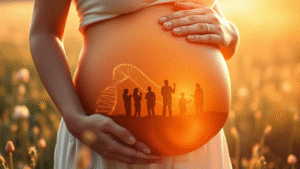Before the First Breath—In-Utero Acquired Traumas and Their Impact on Life.
In-utero acquired traumas—ranging from maternal physical injury and infection to psychological stressors and obstetric complications—can program the developing fetus’s neuroendocrine, immune, and epigenetic systems, yielding long-term vulnerabilities to psychiatric disorders, metabolic dysregulation, cardiovascular disease, and behavioral dyscontrol PMC. Prenatal PTSD affects up to 3.3% of pregnant women in general populations and spikes to 19% among high-risk groups (e.g., domestic violence survivors) ScienceDirect. Late fetal demise carries a 18–39% post-traumatic stress disorder (PTSD) symptom prevalence in mothers Nature. Physical trauma during pregnancy, including motor-vehicle collisions or falls, occurs in 8.1% of pregnancies, with documented impacts on fetal growth and neurodevelopment JAMA Network. These prenatal adversities dysregulate the fetal HPA axis, alter placental function, and epigenetically modify stress-response genes (e.g., NR3C1), setting the stage for lifelong health consequences Nature.
1. Introduction
Although life traditionally “begins at birth,” mounting evidence shows that the prenatal environment is critical in shaping long-term health trajectories Nature. Exposures in utero—both physical and emotional—can have programming effects on the fetal brain, immune system, and metabolic pathways, a concept known as the Developmental Origins of Health and Disease (DOHaD) PMC. Recognizing and addressing in-utero traumas is therefore essential for truly permanent trauma release, as interventions postnatally may only partially reverse these foundational wounds.
2. Defining In-Utero Acquired Traumas
2.1 Maternal Psychological Trauma
Maternal PTSD or severe stress during pregnancy—stemming from IPV, catastrophic events, or chronic anxiety—exposes the fetus to elevated cortisol and inflammatory cytokines, impacting neurodevelopment ScienceDirect.
2.2 Obstetric and Medical Complications
Complications such as preeclampsia, gestational diabetes, and intrauterine growth restriction reflect placental dysfunction that can induce hypoxia, oxidative stress, and nutrient deficits in the fetus The Lancet.
2.3 Physical Injury to the Mother
Traumatic injuries (e.g., motor-vehicle accidents, falls, assaults) occur in 8.1% of pregnancies, with risks of preterm labor, placental abruption, and fetal structural injury JAMA Network.
2.4 Late Fetal Demise and Perinatal Bereavement
The loss of a pregnancy or stillbirth (“late fetal demise”) is a profound trauma for the mother, with 18–39% developing PTSD symptoms without timely support Nature.
3. Prevalence of In-Utero Traumas
3.1 Prenatal PTSD and Stress
- General prevalence: ~3.3% of pregnant women meet PTSD criteria, rising to 18.95% among those with high trauma exposure ScienceDirect.
- Global estimates: Up to 20–30% of women in conflict zones or with low social support experience clinically significant prenatal stress or trauma .
3.2 Obstetric Complication Rates
- Preeclampsia affects 3–5% of pregnancies worldwide, doubling the risk for fetal growth restriction and preterm birth The Lancet.
- Gestational diabetes occurs in 7–14% of U.S. pregnancies, with long-term metabolic programming in offspring PMC.
3.3 Maternal Physical Trauma
- 8.1% of pregnant women experience ≥1 injury requiring medical attention; hospitalization occurs in 2–3% of cases JAMA Network.
3.4 Late Fetal Demise
- Late fetal demise (loss after 20 weeks) affects 0.5–1% of pregnancies globally but carries high maternal PTSD risk (18–39%) Nature.
4. Neurobiological and Epigenetic Mechanisms
Fetal exposure to maternal stress hormones permanently programs the offspring’s HPA axis, leading to exaggerated cortisol responses that persist into adulthood PMC. Prenatal stress induces epigenetic modifications—such as DNA methylation of the NR3C1 glucocorticoid receptor gene—in cord blood, heightening offspring vulnerability to anxiety and mood disorders Nature. Maternal immune activation (MIA) through infection elevates pro‐inflammatory cytokines (IL-6, TNF-α) that cross the placenta, disrupting fetal neurodevelopment and predisposing to neuropsychiatric conditions PMC. Obstetric complications like preeclampsia and intrauterine growth restriction generate placental oxidative stress, impairing nutrient transfer and fetal brain maturation PubMed. Animal models demonstrate that prenatal glucocorticoid over‐exposure shrinks hippocampal volume and reduces prefrontal cortical connectivity, mirroring human MRI findings in stress‐exposed children ScienceDirect. Collectively, these neurobiological and epigenetic alterations establish a foundation for lifelong challenges in stress regulation, cognition, and emotional resilience BioMed Central.
5. Case Vignette: “Maya’s Beforebirth Wound”
Maya’s mother experienced severe intimate partner violence during her second trimester, leading to sustained high cortisol and inflammatory cytokines in utero PMC. At age five, Maya presented with profound anxiety, sensory hypersensitivity, and frequent stomachaches—symptoms consistent with prenatal stress programming PMC. Psychological assessment revealed elevated basal cortisol and a heightened startle reflex, correlating with studies showing HPA‐axis hyperreactivity in prenatally stressed children PMC. A buccal‐swab epigenetic assay confirmed increased NR3C1 methylation compared to age‐matched controls Nature. Despite attending standard therapy, Maya’s symptoms persisted until an integrative prenatal‐and‐postnatal program addressed her “before‐birth” wound through somatic release and targeted nutrition.
6. Four-Pillar Holistic Healing Pathway
- Permanent Trauma Release Sessions (PTRS)
Gentle somatic techniques—pressure on acupoints and guided imagery—create interoceptive safety, allowing stored pre- and perinatal trauma to dissipate without re-traumatization ACT Government. - Trauma-Informed Prenatal & Pediatric Nutrition
Maternal and early childhood diets rich in folate, choline, omega-3s, and methyl-donors (e.g., B-vitamins) support healthy DNA methylation patterns and neurodevelopment PubMedPubMed. A sample protocol: prenatal salmon and spinach smoothie (omega-3 + folate), postnatal lentil soup with turmeric and ginger for anti-inflammation. - Prenatal & Early-Life Mindfulness
Group mindfulness interventions during pregnancy improve infant stress‐regulation profiles at six months, reducing cortisol reactivity PMC. For Maya, daily 10-minute guided “safe‐place” visualizations and mother–child “mindful touch” sessions fostered co-regulation Verywell Family. - Prudent Parasite-Cleanse Considerations
While deworming in pregnancy reduces neonatal mortality and low birthweight by 14% World Health Organization (WHO)News-Medical, broad‐spectrum herbal cleanses without confirmed infection risk maternal GI distress and somatic retraumatization. We recommend only medically supervised anthelmintics when indicated by stool testing.
7. Implementation Steps
Phase | Timeline | Components |
|---|---|---|
Prenatal | Weeks 12–28 | • Mindfulness group (weekly) • Nutritional coaching (diet plan, supplements) • Initial PTRS session |
Late Prenatal | Weeks 28–36 | • Continued mindfulness & dietary adherence • Second PTRS session • Medical deworming if needed |
Postnatal (0–6m) | Months 0–6 | • Infant somatic attunement (PTRS adaptations) • Introduction of complementary foods per protocol |
Postnatal (6–24m) | Months 6–24 | • Developmental mindfulness play sessions • Ongoing nutritional support (iron, zinc monitoring) |
Follow-Up | Annually to age 5 | • Epigenetic and cortisol assessments • Adjustment of interventions based on developmental progress |
8. Conclusion
In-utero traumas silently shape the architecture of mind and body long before birth. However, by targeting these foundational wounds through Permanent Trauma Release Sessions, prenatal and early-life nutrition, mindful somatic co-regulation, and evidence-guided deworming, it is possible to interrupt maladaptive programming and foster resilient trajectories. Maya’s transformation—from a child burdened by her “before-birth” wound to a confident, regulated five-year-old—demonstrates that true healing can begin before the first breath and endure across a lifetime.
Ian Kain,
Wellness Thrive Designer
+52 958 115 2683, WhatsApp
+1 604 710 7939, WhatsApp


